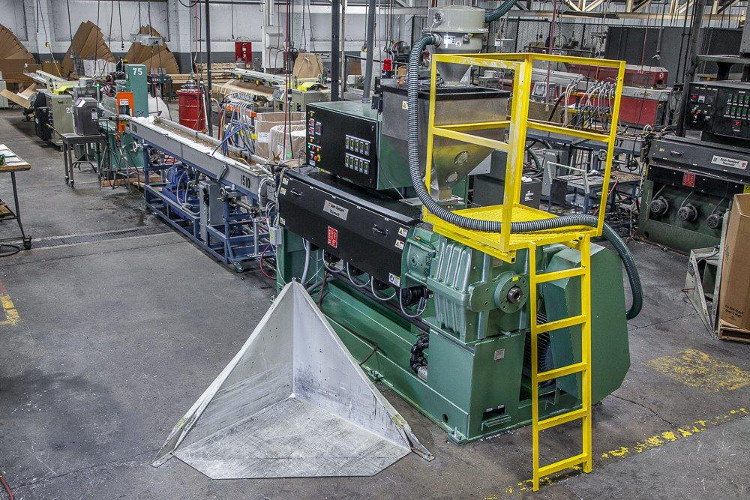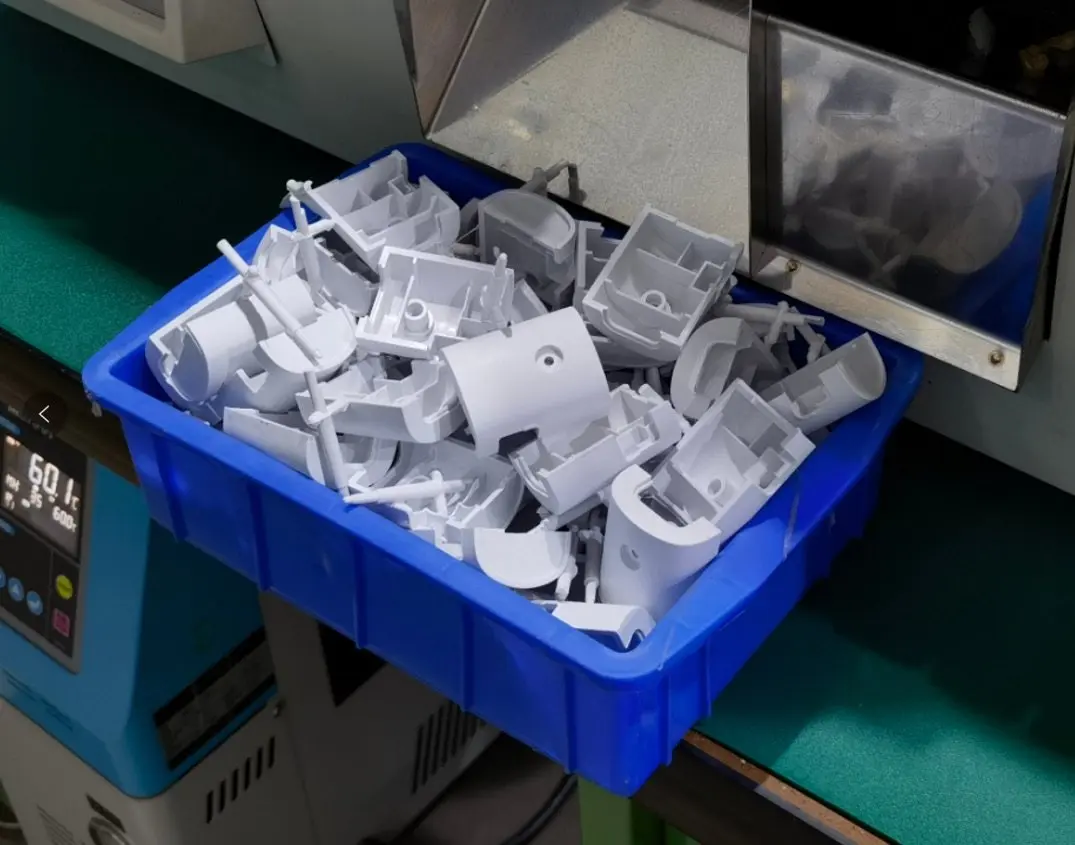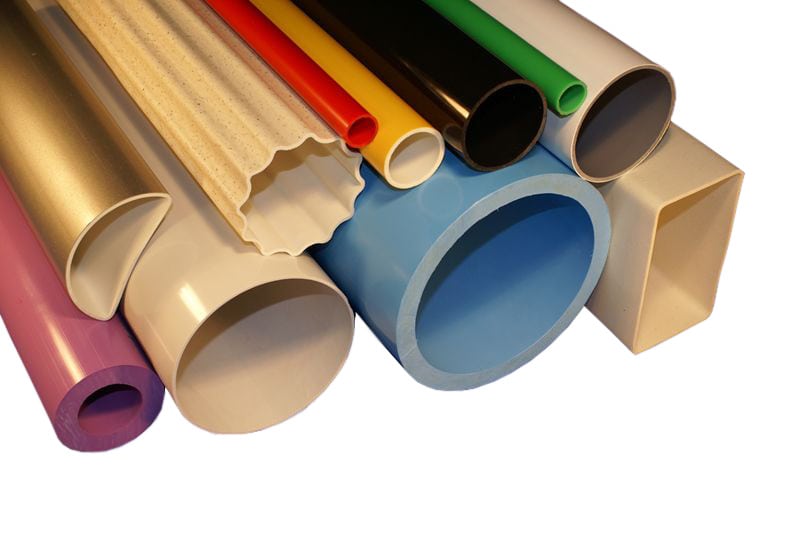The plastic extrusion method of processing involves melting raw plastic pellets and forcing them through a shaped die to create long, continuous profiles.

Types of Plastics Used in Extrusion
In the realm of plastic manufacturing, different types of plastics offer distinct advantages and limitations, especially when it comes to the extrusion process. Understanding the types of plastics involved helps manufacturers make informed decisions about material choice, extrusion settings, and end-use applications. In this section, we delve into the two primary categories of plastics commonly used in extrusion: thermoplastics and thermosetting plastics.
Thermoplastics
Thermoplastics are a popular choice in the extrusion process due to their ease of use and recyclability. When heated, they become soft and moldable, and upon cooling, they harden into the desired shape.
- Polyethylene (PE): Widely used for manufacturing pipes, containers, and packaging films. PE offers excellent chemical resistance and is lightweight.
- Polypropylene (PP): Known for its high melting point and chemical resistance, PP is often used in automotive parts and consumer goods.
- Polystyrene (PS): Commonly used in the production of foam products, PS is also employed in packaging and disposable tableware.
- Polyvinyl Chloride (PVC): Used in everything from pipes to vinyl siding, PVC offers excellent durability and is resistant to environmental degradation.
Thermosetting Plastics
- Epoxy Resins: Typically used in the aerospace and automotive industries for components that need to withstand high temperatures and pressures.
- Phenolics: These are employed in the electrical and heavy machinery industries, particularly for insulation and as a binding agent.
- Melamine: Often used in laminates, melamine is known for its excellent hardness and
The Extrusion Process
The extrusion process serves as a cornerstone in plastic manufacturing, transforming raw plastic materials into specific shapes and profiles. The technique offers flexibility, scalability, and efficiency. To grasp the ins and outs of plastic extrusion, it’s crucial to delve into its core components and procedural steps. This section aims to provide an in-depth look at what makes the extrusion process tick.
Components of an Extruder
Understanding the anatomy of an extruder can be instrumental in comprehending how the extrusion process works. Here are the main components you would typically find in an extruder:
- Hopper: This is the starting point, where raw plastic pellets are fed into the machine.
- Barrel: The barrel houses the screw and is where the plastic gets melted.
- Screw: The screw’s primary function is to move the plastic pellets from the hopper to the die. It also mixes and melts the plastic as it moves along.
- Heater Bands: These are wrapped around the barrel to facilitate the melting of plastic.
- Die: The die gives the melted plastic its shape as it exits the extruder.
- Cooling System: After the plastic exits the die, it must be cooled and solidified quickly.
The Steps Involved
Once you’re familiar with the components of an extruder, understanding the steps in the extrusion process becomes straightforward. Here is a general overview:
- Feeding: Raw plastic pellets are poured into the hopper, initiating the extrusion process.
- Conveying: The screw moves the plastic pellets through the barrel towards the die.
- Melting: As the plastic moves through the heated barrel, it melts into a viscous liquid.
- Shaping: The melted plastic is forced through the die, taking on its final shape.
- Cooling: Immediately after extrusion, the plastic passes through a cooling system to solidify its shape.
- Cutting and Finishing: The extruded plastic is then cut to the desired length and may undergo additional finishing processes, like painting or labeling.
Parameters Affecting Extrusion
The success of the plastic extrusion process doesn’t merely rely on the type of plastic used or the design of the extruder. Various parameters come into play, affecting the efficiency, quality, and overall output of the extrusion process. A detailed understanding of these variables is essential for optimizing the manufacturing procedure and producing high-quality products. Here, we’ll discuss some of the most critical parameters that influence plastic extrusion, including temperature, pressure, and screw speed.
Temperature
Temperature plays a pivotal role in the plastic extrusion process, directly impacting the melting and shaping of the plastic.
- Melting Point: Different plastics have different melting points. Setting the temperature too high can degrade the material, while setting it too low can result in incomplete melting.
- Barrel Heating Zones: Extruders usually have multiple heating zones along the barrel.
- Die Temperature: Too hot or too cold, and the final product might have deformities.
You can learn more about the significance of temperature in plastic extrusion on Wikipedia.
Pressure
Pressure is another essential parameter that can make or break the quality of the extruded plastic.
- Back Pressure: This is the resistance met by the screw as it pushes the molten plastic through the barrel. Proper back pressure ensures adequate mixing and melting.
- Die Pressure: It’s crucial to maintain the right pressure at the die to ensure the plastic comes out in the correct shape and size.
- Pressure Fluctuations: Consistency is key; any sudden changes in pressure can result in defects in the final product.
Screw Speed
The screw’s rotational speed is yet another vital parameter, as it influences both the output rate and the quality of the end product.
- Throughput: A faster screw speed generally leads to higher throughput but might compromise quality.
- Mixing Efficiency: The speed should be set so that the plastic gets sufficiently mixed and melted without degrading the material.
- Harmonization: The screw speed needs to be harmonized with other parameters like temperature and pressure for optimal performance.
Comparing Plastic Extrusion with Other Processing Methods
When it comes to manufacturing plastic products, various methods are available, each with its own set of advantages and limitations. To fully appreciate its role, one should compare it with other prominent plastic manufacturing methods like injection molding, blow molding, and rotational molding. This section aims to highlight the distinctive features, advantages, and drawbacks of each method in relation to plastic extrusion.
Injection Molding
Injection molding is another prevalent method for shaping plastic, and it is often used for creating complex geometries.
- Speed: Injection molding can produce parts much more quickly than extrusion but generally requires more time for setup.
- Flexibility: While it is excellent for complex parts, changing the mold for different products can be expensive and time-consuming.
- Material Utilization: Injection molding typically has less waste compared to extrusion, as excess material can often be regrinded and reused.

Blow Molding
- Speed: Blow molding is generally slower than both extrusion and injection molding when it comes to production speed.
- Complexity: This method is somewhat limited in the complexity of shapes it can produce, especially when compared to injection molding.
- Material Limitations: Blow molding mainly works with materials that have good melt strength, which can be a limitation.
Learn more about blow molding on its Wikipedia page.
Rotational Molding
- Cost-Effectiveness: For large, low-volume parts, rotational molding is often more cost-effective than other methods.
- Flexibility: Rotational molding allows for more design flexibility, particularly in terms of wall thickness and multi-layer constructions.
- Material Restrictions: This method is less versatile in the types of materials it can process compared to extrusion or injection molding.
Applications of Plastic Extrusion
Plastic extrusion finds applications across a wide array of industries, each capitalizing on the method’s inherent advantages such as versatility, high throughput, and economical production costs. The scope and scale of its applications make plastic extrusion a pivotal process in today’s manufacturing landscape. In this section, we will explore some of the most significant sectors where plastic extrusion has made an indelible impact: packaging, construction, and automotive.
Packaging
The packaging industry relies heavily on plastic extrusion for a variety of purposes.
- Film and Sheet Extrusion: Plastic films for food packaging and shopping bags often come from extrusion processes.
- Bottle Production: While blow molding is more common for bottles, extrusion techniques are also used, especially for larger containers.
- Tube and Profiles: Packaging for cosmetics and toiletries often includes extruded plastic tubes.

Construction
In the construction sector, plastic extrusion plays a significant role, particularly in the development of modern, energy-efficient buildings.
- Piping Systems: Plastic pipes for plumbing, made primarily from PVC, are usually extruded.
- Window Frames: Extruded plastic profiles are commonly used for window frames, offering excellent insulation properties.
- Cladding and Insulation: Plastic extrusion is also used to produce cladding materials for better thermal performance.
For more information on plastics in construction, you may refer to the comprehensive details available on Wikipedia.
Automotive
The automotive industry employs plastic extrusion for both functional and aesthetic purposes.
- Interior Components: Various interior elements, such as dashboard panels and door liners, often come from extruded plastics.
- Weather Stripping: The seals that prevent water and air from entering the vehicle are typically made using extrusion.
- Fuel Lines: Advanced extrusion techniques are used to create fuel lines that are both lightweight and durable.




